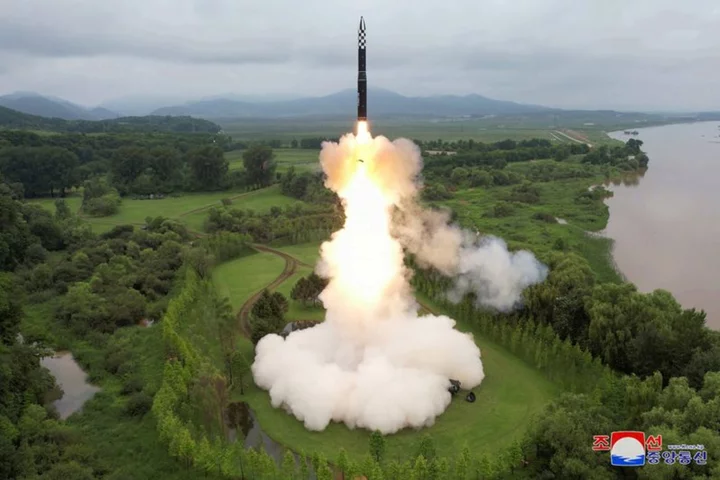By Soo-hyang Choi and Josh Smith
SEOUL (Reuters) -North Korea tested its latest Hwasong-18 intercontinental ballistic missile (ICBM) on Wednesday, its state media reported, saying the weapon is the core of its nuclear strike force and a warning to the United States and other adversaries.
The launch, reported at the time by militaries in South Korea and Japan, was condemned by the U.S. and leaders in Seoul and Tokyo, among others.
The United Nations Security Council, which has passed resolutions banning North Korea's ballistic missile and nuclear weapons development, will meet publicly on Thursday to discuss the missile launch.
The Hwasong-18 was first flown in April. It is the North's first ICBM to use solid propellants, which can allow faster deployment of missiles during a war.
"The test-fire is an essential process aimed at further developing the strategic nuclear force of the Republic and, at the same time, serves as a strong practical warning" to adversaries, state news agency KCNA said.
Accusing Washington of increasing tensions by deploying submarines and bombers to the Korean peninsula and conducting nuclear war planning with South Korean allies, KCNA said the military security situation "has reached the phase of nuclear crisis beyond the Cold War era."
North Korean leader Kim Jong Un oversaw the test, and said the country would take increasingly strong measures to protect itself until the U.S. and its allies drop their hostile policies, the report said.
The Hwasong-18's 74-minute flight time was the longest ever for a North Korean missile test, KCNA said, adding the second and third stages were flown on a lofted trajectory to a high altitude for safety.
"The test-fire had no negative effect on the security of the neighboring countries," it said.
North Korea said the missile flew 1,001 km (622 miles) to an altitude of 6,648 km.
Japan said the missile landed in the sea east of the Korean peninsula and about 250 km west of northern Japan's Okushiri island.
Photos released by KCNA showed the Hwasong-18 being launched from a cannister mounted on a road-mobile, multi-wheeled vehicle known as a transporter erector launcher (TEL), designed to allow missiles to be fired from unpredictable locations.
Colin Zwirko, senior analytic correspondent for NK News, a Seoul-based website that monitors North Korea, noted, however, that Wednesday's launch occurred from the same spot outside Pyongyang as the Hwasong-18's first test, in a field that commercial satellite imagery showed had been purpose built and likely reinforced with concrete beneath the grass.
"Given (Kim Jong Un's) obsession with aesthetics, for all we know there could be no big deception after all (since he knows adversaries will have seen through it) and he just wants to launch missiles from pretty gardens from now on," he said in a post on Twitter.
(Reporting by Soo-hyang Choi; Additional reporting by Josh Smith; Editing by David Gregorio and Stephen Coates)

